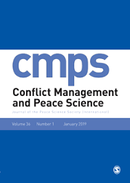The Local Geography of Transnational Terrorism
|
Article: [.pdf]
|
Citation:
Marineau, Josiah, Henry Pascoe, Alex Braithwaite, Michael G. Findley, and Joseph K. Young. 2020. "The Local Geography of Transnational Terrorism." Conflict Management and Peace Science 37(3): 350-381. Abstract: Why are some locations more attractive targets for transnational terrorism than others? Remarkably little is known about the local-level conditions and attributes that determine precisely where transnational terror attacks occur within targeted countries. To date, quantitative terrorism research identifies country- or region-level correlates of terrorism, neglecting possible local factors. In this study, we posit five local-level factors that increase the likelihood of a terror attack: security of a target, accessibility, symbolism, material harm, and exclusion. Using a variety of estimation strategies, including multilevel, negative binomial, and propensity score matching models, we regress new sub-national geographically coded transnational terrorism data on various subnational measures that might theoretically increase the likelihood of a terror attack. The results demonstrate that although country- and region-level factors matter, numerous local-level conditions, including where civil violence occurs, sub-national economic activity, and proximity to capitals and urban areas, are equally, if not more, important. The results help to substantiate the analytical benefits of adopting the sub-national level of analysis in the study of transnational terrorism.
Replication Data: [.zip TBA]
Appendix: [.pdf TBA] Registration: NA |
